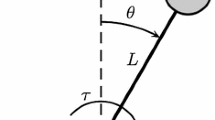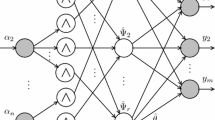Abstract
In this study, a new fuzzy system structure that reduces the number of inputs is proposed for dynamic system identification applications. Algebraic fuzzy systems have some disadvantages due to many inputs. As the number of inputs increase, the number of parameters in the training process increase and hence the classical fuzzy system becomes more complex. In the conventional fuzzy system structure, the past information of both inputs and outputs are also regarded as inputs for dynamic systems, therefore the number of inputs may not be manageable even for “single input and single output” systems. The new dynamic fuzzy system module (DFM) proposed here has only a single input and a single output. We have carried out identification simulations to test the proposed approach and shown that the DFM can successfully identify non-linear dynamic systems and it performs better than the classical fuzzy system.











Similar content being viewed by others
References
Bellazzi R, Guglielmann R, Ironi L (2000) How to improve fuzzy-neural system modeling by means of qualitative simulation. IEEE Trans Neural Netw 11:249–253
Chen MS (1999) A comparative study of learning methods in tuning parameters of fuzzy membership functions, systems, man, and cybernetics. IEEE SMC 1999 Conf Proc 3:40–44
Chen CL, Chen WC (1994) Fuzzy controller design by using neural network techniques. IEEE Trans Fuzzy Syst 2:235–244
Duan JC, Chung FL (2002) Multilevel fuzzy relational systems: structure and identification, Soft Computing 6:71–86, DOI 10.1007/s005000100144
Figueiredu M, Gomide F, Rocha A, Yager R (1993) Comparison of Yager’s level set method for fuzzy logic control with Mamdani’s and Larsen’s methods. IEEE Trans Fuzzy Syst 1:156–159
Gao XZ, Ovaska SJ (2003a) Linguistic information feed-forward-based dynamical fuzzy systems. I. theory. In: Proceedings of the 2003 IEEE international workshop on soft computing in industrial applications SMCia/03, vol 1, pp:73–79
Gao XZ, Ovaska SJ (2003b) Linguistic information feed-forward-based dynamical fuzzy systems. I. Evaluation. In: Proceedings of the 2003 IEEE International Workshop on soft computing in industrial Applications, 2003. SMCia/03, vol 1,pp:81–84.
Gao XZ, Ovaska SJ, Dote Y (2001) DFSLIF: dynamical fuzzy system with linguistic information feedback. In: Proceedings of the 2001 IEEE mountain workshop on soft computing in industrial applications SMCia/01,vol 1,pp121–126
Giles CL, Omlin CW, Thornber KK (1999) Equivalence in knowledge representation: automata, recurrent neural networks, and dynamical fuzzy systems. Proc IEEE 87:1623–1640
Guillaume S (2001) Designing fuzzy inference systems from data: an interpretability-oriented review. IEEE Trans Fuzzy Syst 9:426–443
Hagenblad A, Ljung L (2000) Maximum likelihood estimation of Wiener models. In: Proceedings of the 39th IEEE conference on decision and control, pp 32417–32418
Haverkamp BRJ, Chou CT, Verhaegen U (1998) Subspace identification of continuous-time Wiener models, In: Proceedings of the 37th IEEE conference on decision and control.vol 2,pp:1846–1847
Hojati M, Gazor S (2002) Hybrid adaptive fuzzy identification and control of nonlinear systems. IEEE Trans Fuzzy syst 10:198–210
Huaguang Z, Yongbing Q (2001) Modeling, identification, and control of a class of nonlinear systems. IEEE Trans Fuzzy Syst 9:349–354
Jang JSR (1993) ANFIS: adaptive-network-based fuzzy inference system IEEE Trans Syst Man Cybernet 23:665–684
Jang JSR, Mizutani E (1996) Levenberg–Marquardt method for anfis learning, fuzzy information processing society Biennial conference of the North American. IEEE 1:87–91
Jang JSR, Sun CT (1995) Neuro-fuzzy modeling and control. Proc IEEE 83:378–405
Jin Y, Jiang J, Zhu J (1995) Neural network based fuzzy identification and its application to modeling and control of complex systems. IEEE Trans, Syst Man and Cybernet 25:990–997
Lee CC (1990) Fuzzy logic in control systems: fuzzy logic control-part I. IEEE Trans Syst Man Cybernet 20:404–418
Lee CC (1990) Fuzzy logic in control systems: fuzzy logic control-part II. IEEE Trans Syst Man Cybernet 20:419–435
Lee C-H, Teng C-C (2000) Identification and control of dynamic systems using recurrent fuzzy neural networks. IEEE Trans Fuzzy Syst 8:349–366
Leu YG, Lee TT, Wang WY (1997) On line tuning of fuzzy-neural network for adaptive control of nonlinear dynamical systems. IEEE Trans Syst, Man Cybernet 27:1034–1043
Lin Y, Gunningham III GA (1995) A new approach to fuzzy-neural system modeling. IEEE Trans Fuzzy Syst 3:190–198
Man Z, Yu X, Zang X, Gao XZ (2003) A new dynamical fuzzy modeling and control for SISO complex systems, Industrial Electronics Society, IECON 2003. In: 29th annual conference of the IEEE vol 3, pp 2995–3000
Nauck D (2000) Adaptive rule weights in neuro-fuzzy systems. Neural Comput Appl 9:60–70
Wang LX (1994) Adaptive fuzzy systems and control: design and stability analysis. PTR Prentice-Hall, Englewood Cliffs (NJ)
Wang LX (1995) Design and analysis of fuzzy identifiers of non-linear dynamic systems. IEEE Trans Autom Control 40:11–23
Wang LX (1997) A course in fuzzy systems and control. Prentice Hall, Upper Saddle River (NJ)
Wu S, Er MJ, Gao Y (2001) A fast approach for automatic generation of fuzzy rules by generalized dynamic fuzzy neural networks. IEEE Trans Fuzzy Syst 9:578–594
Yamakawa T, Uchino E (1997) Neo-Fuzzy neuron and its learning algorithms with applications to the modeling of non-linear systems. In: Jamshidi M, Titli A, Zadeh L, Boverie S (eds) Applications of fuzzy logic: towards high machine intelligence quotient systems. Prentice-Hall, Upper Saddle River (NJ), pp 223–243
Yip PPC, Pao YH (1994) A recurrent net approach to one-step ahead control problems. IEEE Trans Syst Man Cybernet 24:678–683
Yu XH, Chen GA, Cheng SX (1995) Dynamic learning rate optimization of back propagation algorithm. IEEE Trans Neural Netw 6:669–677
Author information
Authors and Affiliations
Corresponding author
Rights and permissions
About this article
Cite this article
Alci, M. New dynamic fuzzy structure and dynamic system identification. Soft Comput 10, 87–93 (2006). https://doi.org/10.1007/s00500-004-0428-x
Published:
Issue Date:
DOI: https://doi.org/10.1007/s00500-004-0428-x




